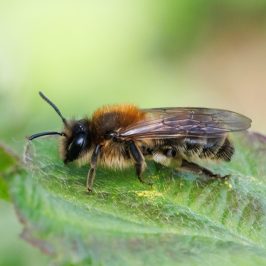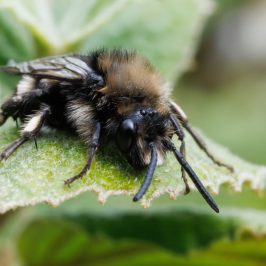After a cold and overcast morning the weather brightened at lunch time, and I took the macro and went out on a bug hunt. My first circuit of the garden produced very little, but as the sun came out and the air warmed up I began to find solitary bees, and then a few hoverflies, and then – O frabjous day! – two bee-flies in my garden, and one on my neighbour’s drive. A quick circuit of the village produced a fourth Bombylius major on a roadside verge, and turned me into a very happy bug hunter indeed.
I’m not sure why I like bee-flies so much, given their reprehensible habits, but I think it may be because they’re an early fly, and therefore a real harbinger of spring. Stop me if I’ve told you this before (I have told you this before), but the female bee-fly coats her eggs in dust and grit, and flicks them into the nests of various Andrena (solitary mining bee) species, where they go unnoticed by the female bees; when they hatch, the bee-fly larvae parasitize the Andrena larvae, and eventually kill them. This, of course, makes me feel very sorry for the poor, hard-working Andrena bees – but objectively I know that bees and bee-flies have been living in balance for a very long time, and in fact the presence of bee-flies is an indicator of a thriving population of mining bees.
The bee-flies in my and my neighbour’s garden are especially keen on the nests of the Ashy mining-bee, Andrena cineraria – in fact, having found two B. major in my own garden, I went next door specifically to look at a bank where I know there are A. cineraria nests, and was smugly happy to find the third bee-fly hanging out there. All four of today’s culprits were males – easily spotted by the fact that their eyes meet in the middle of their heads; the females have wider-spaced eyes, and (at least once they start laying their eggs) permanently gritty bottoms.
Re the whole flicking of the eggs business, I’ve read this factoid in numerous accounts of the bee-fly life cycle, and have accepted it…. but with some reservation. Just this afternoon I was talking to R about it, and commented on how unlikely it sounds that an insect could flick its eggs – and also wondered how anyone might come to observe a fly and decide that that was what it was doing. But this evening I happened across this useful page on bee-flies, which includes a film of a female bee-fly apparently attempting to rid herself of a sticky, gritty egg…. and I have to say that the word “flicking” is actually quite a reasonable one to describe the operation.
For the record, my first B. major of last year appeared on 12th March – adding weight to my current grumping about this spring being several weeks behind last year’s. Also, it’s now nearly two years since I logged the first dotted bee-fly (Bombylius discolor) ever recorded in this bit of Worcestershire, and I haven’t seen one since, so I think it’s about time another one of those turned up.







